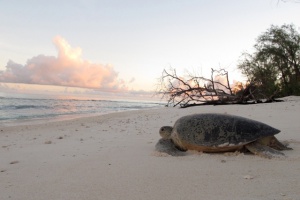'A very rare record'! Green turtle switch nesting grounds from Seychelles atoll of Aldabra to Tanzanian island
Conservation |Author: Sharon Uranie | November 10, 2015, Tuesday @ 16:11| 6846 views
File Photo: Green turtle heading back to the sea after nesting on Aldabra. (SIF)
(Seychelles News Agency) - Seychelles, an archipelago of 115 islands in the Indian Ocean provides feeding grounds for five species of marine turtles but the islands are nesting grounds for only two species - the hawksbill and green turtles.
According to research adult female turtles of both varieties 'often' travel long distances to return to the very same beaches where they themselves were hatched in order to lay their own eggs and repeat the life cycle.
This has been determined through both tagging and genetic studies.
Due to the ‘faithfulness’ to a particular nesting site according to local researchers, in Seychelles hawksbill turtles are seen returning to the same site every two to four years while for green turtles the interval can be much longer.
One recent discovery however has shown that though it is common occurrence, it's not always the case that sea turtles remain faithful to a particular nesting site.
This follows the sighting of an adult female green turtle at a nesting site located more than 700 kilometres away from the Seychelles atoll of Aldabra, the nesting site where it was tagged in 2012.
The turtle was in fact spotted not only at a different nesting site but also in another country, at Juani island in the eastern African country of Tanzania.
According to the Seychelles Islands Foundation SIF, the discovery was made by staff of ‘Sea Sense’ a not-for profit Organisation based in Tanzania, which is involved in the conservation and protection of endangered marine species including sea turtles, dugongs, whales, dolphins and whale sharks.
An SIF spokesperson told SNA that 'Sea Sense' had contacted Seychelles-based researcher, Dr. Jeanne Mortimer, after they identified a metal flipper tag on the turtle that originated from Seychelles.
"The contacted me because they know I work with turtles in Seychelles and the tag said 'return to Seychelles' and I contacted SIF after recognising that it was one of their tags," Mortimer told SNA.
Green turtles which are listed as endangered on the International Union for Conservation of Nature, IUCN’s red list, are more commonly seen on the Seychelles outer islands, including on Aldabra, one of Seychelles’ most far-flung atoll located in the westernmost part of the Indian Ocean archipelago, some 1,100 kilometres from the main island of Mahé.
It is to be noted that Aldabra boasts the second largest population of nesting green turtles (Chelonia mydas) in the Western Indian Ocean.
The atoll’s islands protect a calm, shallow lagoon with lush sea grass beds, diverse coral reefs and undisturbed beaches – all of which provide an ideal habitat for these graceful reptiles.
These unusual features earned the atoll international recognition, as it became part of the Indian Ocean – South-East Asian (IOSEA) Network of Sites of Importance for Marine Turtles late last year.
Dr Mortimer, who is an American-born marine biologist specialising in the conservation of turtles has described the spotting of the green turtle that nested on Aldabra three years ago now nesting in Tanzania as “a very rare record.”
"It's true that most turtles will return to nest at the same site but it's also true that some of them don't but it's very rare," she told SNA adding that she has recorded a few examples of this in Seychelles during her long years of working with turtles in the Indian Ocean island nation.
Dr Mortimer has been living in Seychelles since 1981 and she has been involved in various studies on sea turtles.
“As is the case for humans, turtles have individual personalities, and each individual contributes to its society in a different way. It is usual for most turtles to return to the same nesting beach where they were born, because that site has a proven history of healthy offspring production. But what if the site is destroyed? What if the beach erodes or the island sinks? Such an event could prevent members of the nesting colony from successful reproduction,” adds Mortimer.
“Fortunately, ‘adventurous’ turtles like this one might establish new breeding populations at these remote sites. Given enough time, perhaps hundreds of years, new healthy colonies might become established at these distant sites to secure the future of the species."
While it is impossible to know why this particular green turtle was led to a different nesting site, tagging exercises in previous years have confirmed that sea turtles do travel long distances after laying their eggs.
“SIF have tagged several female Green Turtles from Aldabra with satellite transmitters, and their post-nesting journeys showed that migrations to the east coast of Africa were not uncommon,” says SIF.
“These journeys however, were made to feeding grounds for what is known as a remigration interval, where the turtles spend a number of years fattening themselves up in preparation for another nesting season"
What is believed to be the largest distance covered by a green turtle during migration was reported in July last year by Dr Mortimer together with researchers from the University of Swansea in the United Kingdom and Deakin University’s Centre for Integrative Ecology (CIE) in Australia.
The movement of the marine species which was monitored through satellite tracking showed that it travelled 3,979 km in a single year, starting off in the remote central Indian Ocean Chagos archipelago and ending up off the western Indian coast of Somalia in East Africa.
Back
